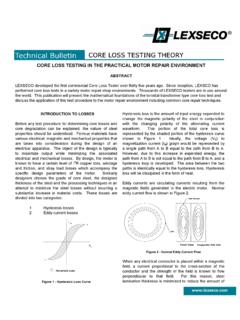Transcription of Wound Rotor Repair Tips: Testing, Application and …
1 Wound Rotor Repair tips : testing , Application and failure AnalysisEASA Convention 2013 Mandalay Bay ResortLas Vegas, NVJuly 1, 2013 Presented byChuck YungSenior Technical Support SpecialistElectrical Apparatus Service AssociationSt. Louis, MO1 Wound Rotor (WR) motors represent only a small fraction of all electric motors in service. Reviewing the Technical Support call logs, one might conclude that the proportion of Wound Rotor motors in service is far greater. Because many of us do not work on Wound Rotor motors very often, it is understandable that not everyone has a clear understanding of how they differ from a squirrel cage motor. The purpose of this article is to dispel some misconceptions about how they work, and to offer valu-able tips for failure analysis , Repair and , ball mils and crane hoists are common applications for Wound Rotor motors, because of their varying speed-torque requirements.
2 The benefit of a Wound Rotor motor is that the resistance of the Rotor circuit can be externally varied, to provide either variable resis-tance (in the case of a liquid rheostat) or steps (when a series of external resistors of fixed resistance are used), to maximize the torque to suit a particular Application . HOW DOES A Wound Rotor MOTOR WORK?In Figure 1, the highlighted path along the several torque curves illustrates this advantage. Beginning with torque curve C, then stepping to curve B, and on to curve A allows the motor to produce the maximum pos-sible torque as it accelerates along those torque curves. Depending on the external resistance added to that of the Rotor , torque curves D through G could result. None of those would be a good choice for an Application re-quiring a large amount of torque to start or accelerate a load. Each might offer benefits if increased slip / reduced speed were desired.
3 For example, although uncommon, a Wound Rotor motor can be used in a pumping applica-tion to reduce speed and, therefor ABOUT THE SECONDARY VOLTAGE?One of the first differences noted, before even disman-tling a Wound Rotor machine, is the secondary voltage (and secondary current) reported on the nameplate. That label leads to understandable confusion about how a Wound Rotor motor actually #1: They energize the Rotor too. Contrary to the nameplate marking, the Rotor is not energized by an external power source during service. As with a squirrel cage induction motor, the Rotor is the secondary winding to the primary stator winding. The secondary voltage on the nameplate indicates the trans-former ratio between the stator and Rotor windings. This is used to calculate the external resistance required to obtain the desired torque for each step. In operation, the stator is energized just as a squirrel cage induction motor (SCIM), but the Rotor leads are connected to variable external resistance.
4 This often takes the form of a series of contactors to a resistor grid, with multiple steps to provide different resistance at each step. Figure 1, from the EASA Technical Manual, llustrates the torque curves that result for each specific Rotor circuit resistance. More specifically, the external resistance in series with the Rotor leads changes at each step to provide maximum torque. Visualize the torque curve of the motor as following the highlighted portion of those different torque curves. When set up correctly, just as the torque of one step falls off, the operator steps to the next of the high-torque capability, the Wound Rotor motor is popular for crane applications . Pay attention the next time someone in your service center is assembling a large vertical motor. It s likely they will tap-tap-tap on the down button to gingerly lower the stator over the ro-tor.
5 Each tap has the potential to cause a rapid restrike failure of the windings (see EASA s Root Cause failure analysis , Page 3-20). Predictably, this causes a failure at the weak link in a Wound Rotor motor this would be By Chuck Yung Senior Technical Support SpecialistElectrical Apparatus Service Association, Inc. St. Louis, MOWOUND Rotor Repair tips : testing , Application AND failure ANALYSISFIGURE 1: ADVANTAGE OF A Wound Rotor MOTOR02550751001251501752002252502550751 000 GFEDCBAPERCENT SYNCHRONOUS SPEEDPERCENT FULL-LOAD TORQUEMax. Torque2the Rotor lead connection to a slip inspecting a Wound Rotor motor and the Rotor lead is the point of failure , the transient caused by a rapid restrike is a strong contender for the root cause of the failure . If it was not caused by an operator tapping the button, it could be a weak magnetic holding coil allowing a contactor to chatter, damaged contacts on one of those contactors, or even a damaged resistor machines sometimes use a saltwater rheostat; with fixed contacts immersed to varying depths in a con-ductive liquid such as a brine solution.
6 Some controls manually raise and lower the contact tong into the solu-tion, but most raise and lower the level of the solution around the fixed stator and Rotor are rewound just like any three-phase winding, with the added consideration of securing the Rotor windings against centrifugal forces. EASA Tech Note 36 can help you calculate the amount of banding required to withstand those more circuits a Rotor has, the more it tries to behave like a SCIM. If a 4-pole Rotor has a 4-delta connection, consider reducing the circuits and turns in proportion (and increasing the wire area in inverse proportion). The motor s speed control will improve, and the volts/coil stresses will be reduced. (See Figure 2.)Misconception #2: We can t have the same num-ber of circuits on the Rotor as on the stator. Or If the Rotor is wye, the stator needs to be delta. The number of circuits for the stator and Rotor , and the selection of wye or delta connection (as well as the jumper arrangement in most cases), are independent of each other.
7 In other words, it does not matter if the stator and Rotor have the same circuits, or a different number of circuits. Either (or both) stator and/or Rotor can be connected wye or stator and Rotor should pass a surge test. Just as you can apply 15% of rated stator voltage to perform an open stator ball test, you can apply 15% of secondary voltage to ball test the Rotor . Bonus tip: Use a replacement garage door roller as a dummy Rotor . Use acrylic sleeving or electrical tape on the shank to insulate the handle. Keep a finger on the roller as it turns, so you can detect a dead spot or reversed tips , AFTER ASSEMBLYA fter assembling the Wound Rotor motor, some tech-nicians discover another anomaly unique to the Wound Rotor motor. Because the stator and Rotor each contain a 3-phase winding, the number of slots must be divis-ible by three (3 phases). The slot count also has to be compatible with the number of poles.
8 That means that there is inherently a bad stator slot Rotor slot combi-nation (Table 1). Two common concerns, when trying to run a Wound Rotor motor in the service center, are cusp and cogging. Without the external resistance in the ro-tor circuit, cogging or a cusp is likely. Electrical noise is another possibility. The two probable explanations for electrical noise are: a bad stator slot- Rotor slot combination an eccentric air gapTo rule out the eccentric air gap, run the motor at half rated voltage. If the air gap is not uniform within 10% of the average, the motor will be very noisy at rated voltage. The magnetic flux varies as the square of the voltage, and the decibel scale is a logarithmic scale, so a motor with an eccentric air gap will not be noisy at half of rated running the motor, with the Rotor leads open, apply rated voltage to the stator leads and measure the voltage between slip rings.
9 It should be balanced, and within 10% of the secondary voltage reported on the nameplate. For larger machines, or those rated above 2 kV, it is acceptable to apply a fraction of rated voltage, FIGURE 2: RANDOM OR FORM WOUNDThe random Wound Rotor can be Wound as a conven-tional lap winding, to reduce the connection form Wound rotors use push-through coils, a wave winding, with only 1 or 2 compare the ratio of applied primary to secondary voltage to that of the the results are as expected, we now know that the turn ratio between stator and Rotor is correct. Therefore, the turns and connection of both Rotor and stator are correct. The Rotor should not rotate during this test, but the more parallel circuits the Rotor has, the more likely it will do so. In most cases, very little torque develops under open Rotor conditions. Because this is a transformer test, if the Rotor was spinning the second-ary voltage (and frequency) would decrease.
10 To obtain accurate values, the shaft must be connect the Rotor leads together, and run the mo-tor as a SCIM. The magnetizing current should follow the expected norms. (See No-Load Current Basics: Practical Guidelines for Assessment, Currents, February 2005).Bonus tip: Be sure the brushes are fully seated. If you run a Wound Rotor motor with brushes that are barely contacting the slip rings, the motor may draw high optional test is to connect the stator leads together, and run the motor by energizing the Rotor leads at the rated secondary voltage. One benefit to doing so is that, if an eccentric air gap is suspected, the electrical noise will still be present. As with the stator test, above, operation at half of the secondary voltage should greatly reduce or eliminate the noise. The ratio of magnetizing current ( no-load amps) for the Rotor and stator should be similar.






